Radar systems are used across many industries and in a variety of commercial, industrial and defense applications. Uses range from commercial applications such as automotive collision avoidance, weather and air traffic control (ATC) to defense systems such as early warning and missile tracking. The radar’s application dictates its physical size, operating frequency, waveform, transmit power, antenna aperture and many other parameters. Every parameter and component must be tested to ensure proper operation.
Radar system operators are interested in functionality testing, namely target detection and tracking. To ensure the accuracy and resolution, detection and false alarm rate of the radar, targets must be generated over the entire unambiguous range, the unambiguous radial velocity interval, azimuth and elevation angles and different radar cross sections (RCS). Testing in the field can be extremely time-consuming, complex and expensive. Repeatable conditions are difficult to configure. For example, consider a radar on a fighter jet that is tested at a test range, where artificial targets are deployed, detected and tracked. The global positioning system (GPS) coordinates of the targets are compared with the collected radar data to verify radar performance.
Since the cost of field-testing can be prohibitive if done on a regular basis, an alternative is to set up “real-life” radar simulations that include many different types of targets and scenarios. Generating radar targets makes it possible to test the functionality of the radar, including RF, without the expense of field testing. Radar target generators can introduce targets with time delay, Doppler frequency shift and attenuation. Several implementations of target generators have been used, including coaxial delay lines (CDL), fiber optical delay lines (FODL) and digital radio frequency memory (DRFM). Commercial off-the-shelf (COTS) measuring equipment is increasingly used.
The performance and capability of radar target generators to test a radar system depend on several technical parameters. This article explains the different target generator architectures, clarifies the performance needs and design criteria that favor one approach over another and shows examples of measurement results with a COTS system.
Radar Tests – Lab or Field?
Many measurements must be performed before a radar system is put into service. During research and development (R&D), mainly hardware component tests are performed. Most of these focus on the transmitter and receiver, with less emphasis on the signal processing and system functionality. As a result, the radar is only partially tested during R&D and important functionality, such as signal detection, is never completely tested in closed-loop operation. To evaluate the complete system (RF and baseband) and ensure that all elements meet specifications and customer requirements, many additional tests are required, as shown in Figure 1.
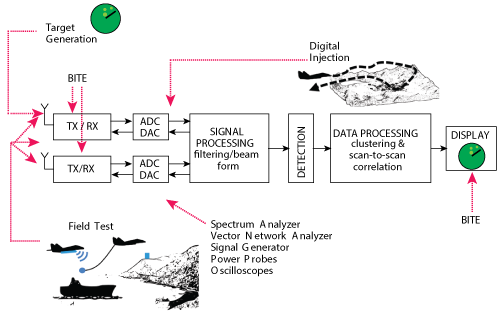
Figure 1 Extensive tests are performed on a multipurpose radar system.
Parametric measurements must be supplemented by tests to evaluate the functionality of the system. Built-in test equipment (BITE) monitors some hardware components and functionalities. While BITE is able to provide a pass-fail assessment, it is not necessarily designed to give information on the radar’s performance. If a radar does not detect a target, for example, how does the operator know that the radar is not functioning properly?
To address this, field tests with towed spheres may be conducted to baseline radar capabilities and evaluate the entire radar processing chain. However, field tests won’t specifically test the processing capabilities. So some radars have a digital injection capability, where scenarios can be loaded into the radar processor to test the processor.
As previously mentioned, field tests are expensive and barely reproducible, and the availability of certain targets is limited. For these reasons, radar target generators are used to replace some field tests and make tests reproducible; they save time and reduce cost and can test the entire processing chain by injecting targets. The technical demands placed on radar target generators represent a challenge to the fundamental architecture of the target generation system. While economic advantages tend to favor a laboratory test system instead of field testing, the functional performance of the radar system must be verified through a balance of laboratory and field test environments. Furthermore, as radar systems add electronic protection functionality, these new system capabilities may require new test methods.
The test and measurement (T&M) industry offers various types of radar test equipment that can be used during development and production. These focus on the parametric performance of the radar and can measure spectral purity, transmit power and sensitivity.
Radar Target Generators
Radar target generators apply time delay (range), Doppler frequency shift (radial velocity) and attenuation to a radar signal. The actual radar signal is received, manipulated and retransmitted. Other systems have the radar waveform stored and trigger waveform replay. The architecture of radar target generators determines the performance and capability to test different levels of functionality. Some are able to generate a single target in a dedicated frequency band, for very specific radar systems, while others cover a wide frequency spectrum and offer complex target scenario simulation. There are also specific radar target generators for dedicated frequency bands, such as for testing automotive radar sensors.1

Figure 2 Simplified block diagram of a fiber optical delay line (FODL).
The performance and capability of radar target generators and their ability to test a radar system depend on several economic and technical parameters. Aside from efficiency and cost, the following technical parameters are important:
- System architecture
- Frequency coverage and bandwidth
- Phase noise performance, signal distortion, spurious emissions and overall echo signal quality
- Digitization performance, sampling frequency and number of effective quantization bits
- Maximum Doppler frequency shift and Doppler steps
- Maximum range, minimum range and range steps
- Trigger and/or continuous operation
- Flexibility to reproduce authentic environmental scenarios and possible tests of interest.
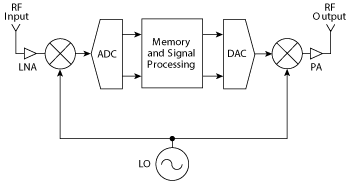
Figure 3 Simplified block diagram of a DRFM system.
Operating frequencies of radar systems vary over a wide range of bands: Long range surveillance radars operate in high frequency (HF) or L-Band, ATC radars in S-Band, naval surveillance radars in X-Band and automotive radar sensors in K- and W-Band. Therefore, the radar target generator should cover a broad spectrum. The bandwidth of the target generator must faithfully reproduce the radar waveform, as bandwidth determines the range resolution and the span of frequency agile radars.
Signal fidelity and phase noise are also important. Poor signal fidelity distorts the retransmitted signal. The radar can only detect slow moving targets if it has low phase noise performance; if the target generator has high additive phase noise, it may limit the ability to assess the actual performance of the radar.
To simulate delay and Doppler, digitization is used in most modern radar target generators. The radar signal is captured, digitized, manipulated, converted to analog and retransmitted with attenuation. The effective number of bits (ENOB) and spurious-free dynamic range (SFDR) quantify the quality of an analog-to-digital converter (ADC) and are important parameters for accurately representing the incoming radar signal and reproducing the radar echo. Other parameters, such as the minimum and maximum range, the number of targets or test scenarios, mainly depend on the signal processing performance, architecture and baseband processing capabilities of the radar target generator.
Today, radar engineers use the following types of radar target generators:
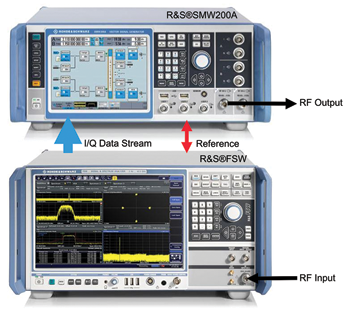
Figure 4 Example of a COTS radar target generator using the R&S®SMW200A vector signal generator and R&S®FSW signal and spectrum analyzer.
Fiber Optic Delay Lines (FODL)
FODLs have been used for several decades to test radar systems, measuring phase noise and simulating reproducible signals for outdoor range testing. These small, relatively flexible, and phase-coherent systems convert the RF signal to optical, delay it with a fiber optic line of a defined length, reconvert it to RF and retransmit it to the radar (see Figure 2). Some systems are able to introduce Doppler frequency shift.
The phase velocity of an optical signal in fiber is approximately 5 µs/km, and the loss is on the order of 0.5 dB/km. Hence, the FODL achieve very good range spacings, i.e., in the domain of picoseconds, when cut properly. The bandwidth of a FODL is very high. With multimode fibers, bandwidth is mainly limited by the modal dispersion, which is in the range of GHz/km. In single-mode fibers, modulation bandwidth is limited by material dispersion and can be 100 GHz/km for a wavelength with very low dispersion.2 Dynamic range is limited by quantum noise at low RF and by nonlinear processes at high RF,3 decreasing linearly with increasing signal bandwidth.2 With a Doppler shift added, the spurious-free dynamic range depends on additional factors and is often reduced by dozens of dB. Although the Doppler frequency shift can modulate the RF signal, the length of the fiber delay (i.e., the range) is constant, and a realistic moving target cannot be generated.
FODLs have several advantages. They have constant delay versus frequency, are immune to vibration and largely resistant to electromagnetic interference, and fiber does not radiate energy. Repeatability of simulation, low system cost and time-savings are also advantages. Where excellent close-in carrier phase noise performance is necessary, such as the fixed target suppression test, FODLs perform very well. However, they cannot generate time-variant range-Doppler targets, nor do they offer continuous range settings or arbitrary signal attenuation and gain.
Digital Radio Frequency Memory (DRFM)
DRFMs manipulate the radar signal digitally, as shown in Figure 3. A DRFM down converts, filters and digitizes the received RF signal. The digital data is stored and/or modified, then reconverted to analog and up-converted to RF using the same local oscillator (LO) used for down conversion. Amplification and retransmission of the RF finalizes the processing chain.
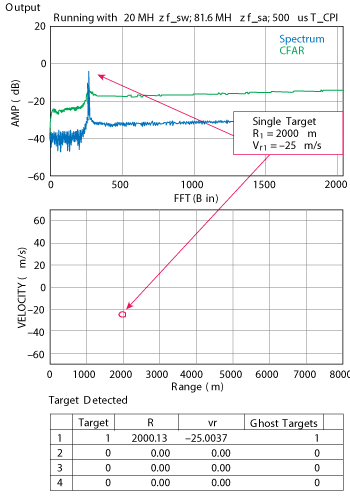
Figure 5 MATLAB® display of a SDR detecting a single target at a range of 2000 m and moving at –25 m/s.
The ALQ-165 airborne self-protection jammer (ASPJ) was one of the first DRFMs designed, with development beginning in 1979.4 ASPJ initially covered 0.7 to 18 GHz and later, from 1 to 35 GHz. The average cost was $1.27 million.5
Technical performance specifications and the cost of a DRFM are rarely available publicly. From what information is available, the cost of a single DRFM module ranges from $150 to $700 thousand, depending on capabilities.6 DRFMs can cover up to 40 GHz, offer 12-bit digitization with 1.4 GHz instantaneous bandwidth, -65 dBc SFDR and a minimum delay of 90 ns. Due to technical restrictions, however, these figures cannot be combined into a single DRFM. For example, most of the wideband DRFMs have lower signal fidelity and use less than 12 bits.
The minimum delay is primarily limited by the ADC and DAC, which take several cycles to convert the analog data to digital and vice versa. The delay also depends on the bandwidth and number of bits. Signal processing adds a number of processing cycles to the radar echo signal. Typical minimum delays now range from below 100 ns to below 1 µs.
With DRFMs it is important to know how the analog RF signal is represented in the digital domain: the number of bits, amplitude and phase. These determine the signal fidelity. Another key parameter is the SFDR, because the radar may try to discriminate between targets and electronic countermeasure (ECM) signals. The SFDR will be limited depending on the ENOB, nonlinearity of components and the noise.
While high signal fidelity DRFMs with coherent target echo returns may be suitable for radar tests, the use of a DRFM with a user interface to test a broad variety of signal conditions and scene effects may be limited. This very dedicated equipment comes at a price and perhaps, with limited flexibility to thoroughly test the functional parameters of the radar.
Commercial Off-the-Shelf (COTS) Test and Measurement Equipment
COTS test and measurement equipment is also able to generate radar targets, in a similar fashion as DRFMs, by RF down conversion, baseband digital signal processing and RF up conversion.
While an RF signal analyzer and RF signal generator are normally used stand-alone, the two instruments can operate as a radar target generator when used together. The radar target generator uses the signal analyzer as the receiver and the signal generator as the transmitter.
A COTS system, as shown in Figure 4, operates from 100 kHz to 40 GHz and will process any type of RF radar signal in this frequency range with up to 160 MHz bandwidth. The signal analyzer converts the incoming radar signal to in-phase and quadrature-phase (I/Q) data. The I/Q data is transferred to the baseband input of the signal generator, where time delay, Doppler frequency shift and attenuation are applied as defined by the user. The radar echo signal is then retransmitted to the radar by the signal generator.
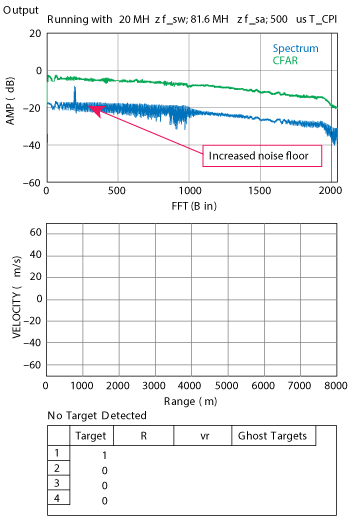
Figure 6 Display of the SDR detecting the same target in the presence of a CW frequency-modulated interfering signal.
One advantage of using COTS measuring equipment is its exceptional RF performance, which is suitable for additional parametric radar tests during research and development or production. The flexible and modular approach allows the vector signal generator and signal and spectrum analyzer to be used in other setups or in a dedicated field installation.
COTS Radar Target Generator Demo
A software defined radar (SDR) using MATLAB® signal processing can demonstrate the capability of a COTS radar target generator. A single target with a range of 2000 m and velocity of -25 m/sec is created by the radar target generator and “detected” by the SDR. The MATLAB® graphical user interface (GUI) of the radar (see Figure 5) shows the spectrum (top), range-Doppler map (middle) and target list (bottom). The spectrum plot shows a single local maxima whose power is higher than the constant false alarm rate (CFAR) threshold. By measuring the beat frequency, the range and radial velocity are calculated, which match the target created by the radar target generator.
The COTS radar target generator can generate up to 20 targets in different range-Doppler cells. The signal generator also has multiple RF sources, making it possible to test the radar in the presence of interference, such as cellular or other services.7 Figure 6 shows the same radar target with a second, frequency-modulated continuous-wave signal. The noise floor is significantly higher. While the radar echo signal can still be observed visually, the CFAR threshold is too high for an automatic detection.
In addition to testing the functional performance of the radar, the COTS target generator can help assess modern electronic protection measures in the radar, such as detecting the presence of a DRFM used as a jammer. An example of the importance of this occurred in mid-2014, when several aircraft vanished from ATC radar screens in Europe, which occurred coincidentally with military exercises.8
A phase-modulated radar waveform, such as a Barker code, can be used to test the performance of the radar’s signal processing. The Barker code is transmitted and delayed in the radar target simulator. The radar has a very specific baseband waveform, and the radar receiver can detect the fidelity of the echo and, using correlation filters, whether the echo is virtual or real. An uncorrelated signal might result from an ECM system, due to resampling at a different rate, a small number of effective bits in the ADC, phase noise or amplifier distortions in the target simulator. Depending on the DRFM, the generated echo signal fidelity will likely be different than one from a real target.
The radar processes focused on electronic protection can detect differences in fidelity in the returned echo. Figure 7 shows a Barker-coded radar signal at the beginning of the measurement and the corresponding radar echo signal attenuated about 50 dB and delayed by 40 µs. The lower plot shows the return signal processed with the correlation filter. Figure 8 shows the echo signal processed with a different sampling rate, as might occur in a DRFM. The different signal fidelity causes the correlation of the echo signal to change fairly dramatically.
Conclusion
The reliability expected of radar systems is extremely high, which is why test and measurement is very important. This article presented several different approaches to using radar target generators to test the entire radar system, including the antenna, transmitter, receiver and signal processing. Comparing the technical performance and economic factors, a perfect balance would bring many field tests into the lab and reduce the cost of software and hardware testing.
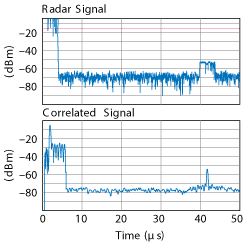
Figure 7 Barker-coded radar signal (top), showing the echo after 40 µs, correlated echo signal (bottom).
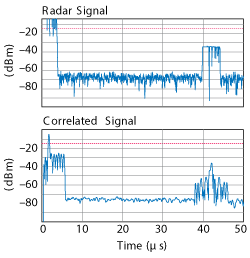
Figure 8 Barker-coded radar signal (top) with an uncorrelated echo, representing a DRFM return signal created at a different sampling rate (bottom).
The target generator’s RF performance must be better than the performance of the radar and offer a variety of test scenarios. FODLs are still used but lack flexibility, for example in generating range-Doppler-dependent targets. A DRFM overcomes this drawback and offers additional options for generating radar echo signals. However, DRFMs are dedicated solutions, can be costly and are not designed to be as flexible as test equipment. COTS test and measurement equipment offers a wide range of test solutions, from signal and component test and analysis to radar target generation. Such equipment is modular, multi-purpose and flexible; it can be used both as a radar target generator and serve other functions in a laboratory.
These different radar target generator approaches each have their own advantages, yet all bring parts of the field test into the laboratory, reducing test complexity and lowering costs. They provide repeatability and automated test capabilities.
References
- “Rohde & Schwarz Enables Comprehensive Automotive Radar Tests with Target Simulator and FM CW Signal Analysis,” press release, www.rohde-schwarz.com/ad/press/automotive, October 2014.
- K.P. Jackson et. al., “Optical Fiber Delay-Line Signal Processing,” IEEE Transactions on Microwave Theory and Techniques, Vol. MTT-33, No. 3, pp. 193–210, March 1985.
- K. Ogawa, “Considerations for Single Mode Fiber Systems,” Bell Syst. Tech. Journal, Vol. 61, pp. 1919–1931, 1982.
- N. Friedman, “The Naval Institute Guide to World Naval Weapons Systems,” 1997–1998.
- “AN/ALQ-165 Airborne Self-Protection Jammer (ASPJ),” www.dote.osd.mil, October 2014.
- Small Business Innovation Research (SBIR), Navy, Topic N131-006, Acquisition Program, “Direct Digital Radio Frequency (RF) Conversion Digital Radio Frequency Memory (DRFM),” 2013.
- S. Heuel and A. Roessler, “Co-existence Tests for S-Band Radar and LTE Networks,” Microwave Journal - Military Microwaves, August 2014.
- Reuters, “Jets Vanishing from Europe Radar Linked to War Games,” www.reuters.com/article/2014/06/13/us-europe-airplanes-safety-idUSKBN0EO1CW20140613, November 2014.
